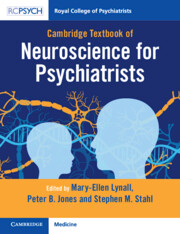Book contents
- Cambridge Textbook Of Neuroscience for Psychiatrists
- Reviews
- Cambridge Textbook of Neuroscience for Psychiatrists
- Copyright page
- Contents
- Contributors
- Introduction
- 1 Cells
- 2 Neurotransmitters and Receptors
- 3 Basic Techniques in Neuroscience
- 3.1 Recording from the Brain
- 3.2 Perturbing Brain Function
- 3.3 Animal Models of Psychiatric Disease
- 3.4 Data Analysis and Computational Modelling
- 3.5 Functional Neuroimaging and Connectivity
- 4 Neuroanatomy
- 5 Neural Circuits
- 6 Modulators
- 7 Genetics
- 8 Neurodevelopment and Neuroplasticity
- 9 Integrated Neurobiology of Specific Syndromes and Treatments
- 10 Neurodegeneration
- Index
- References
3.5 - Functional Neuroimaging and Connectivity
from 3 - Basic Techniques in Neuroscience
Published online by Cambridge University Press: 08 November 2023
- Cambridge Textbook Of Neuroscience for Psychiatrists
- Reviews
- Cambridge Textbook of Neuroscience for Psychiatrists
- Copyright page
- Contents
- Contributors
- Introduction
- 1 Cells
- 2 Neurotransmitters and Receptors
- 3 Basic Techniques in Neuroscience
- 3.1 Recording from the Brain
- 3.2 Perturbing Brain Function
- 3.3 Animal Models of Psychiatric Disease
- 3.4 Data Analysis and Computational Modelling
- 3.5 Functional Neuroimaging and Connectivity
- 4 Neuroanatomy
- 5 Neural Circuits
- 6 Modulators
- 7 Genetics
- 8 Neurodevelopment and Neuroplasticity
- 9 Integrated Neurobiology of Specific Syndromes and Treatments
- 10 Neurodegeneration
- Index
- References
Summary
In correlative neuroimaging research, traditional designs relate brain activity (measured, for example, with EEG, MEG, PET or BOLD fMRI) to performance of some behavioural or cognitive task, suitably adapted for the physical requirements of the scanning process. In block designs, periods of time when a subject is performing some task are compared with periods during which they’re not (an important question being: ‘What are they doing instead?’). For example, one would expect that ‘time spent watching a chequerboard pattern’ would involve more activation of visual cortex than ‘time spent watching a grey screen’, and indeed it does; one can map visual cortex in this way.
- Type
- Chapter
- Information
- Cambridge Textbook of Neuroscience for Psychiatrists , pp. 71 - 75Publisher: Cambridge University PressPrint publication year: 2023

